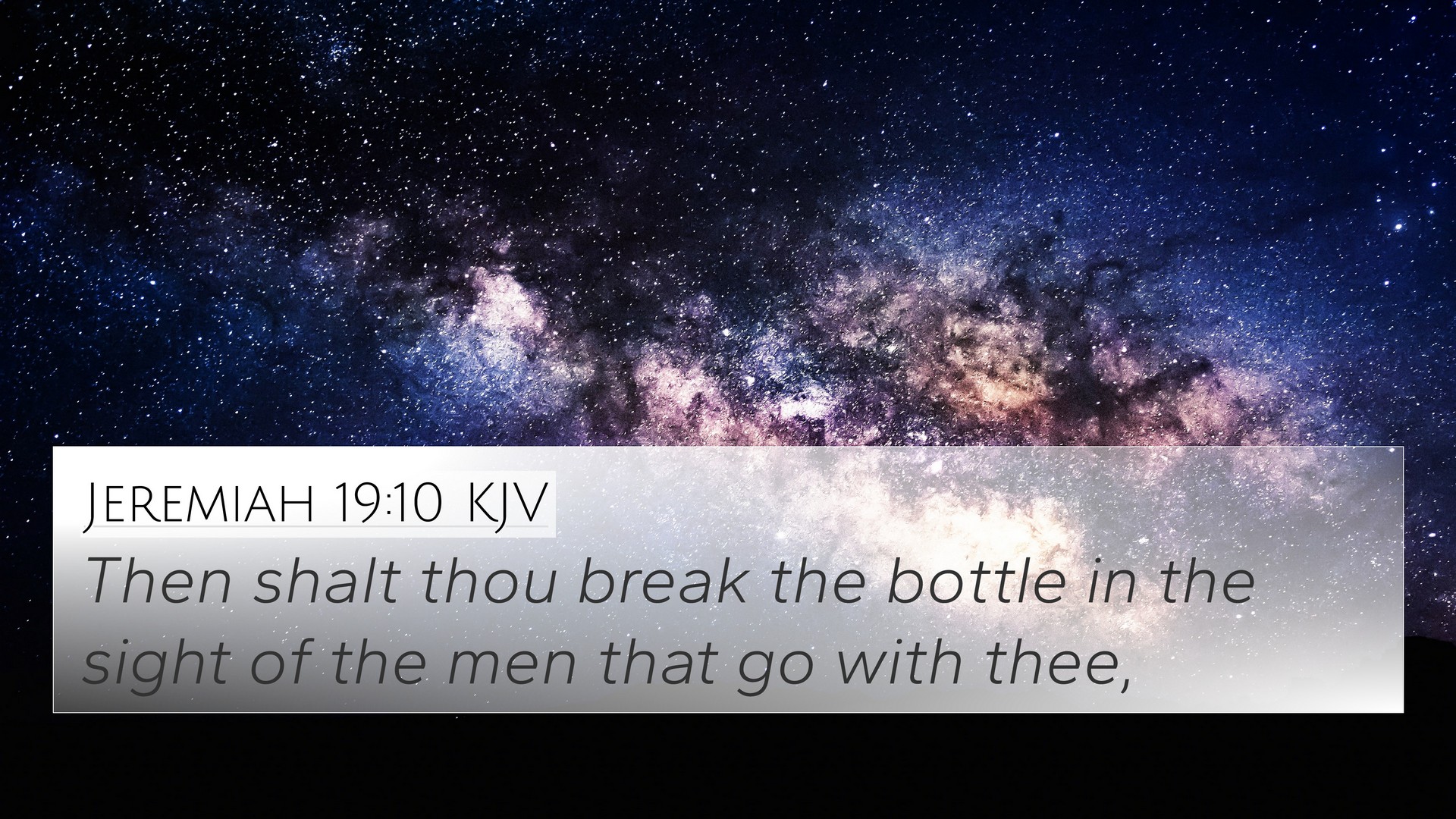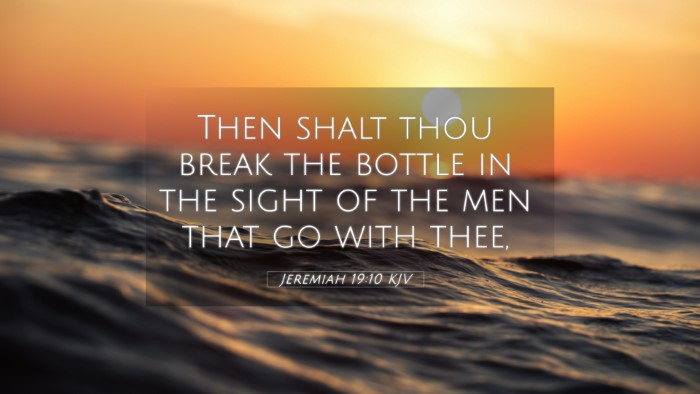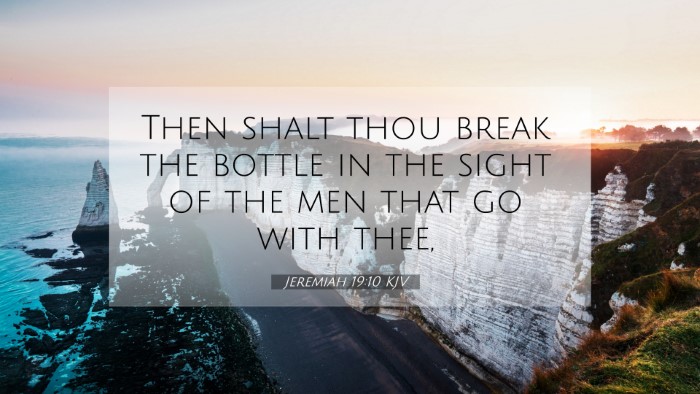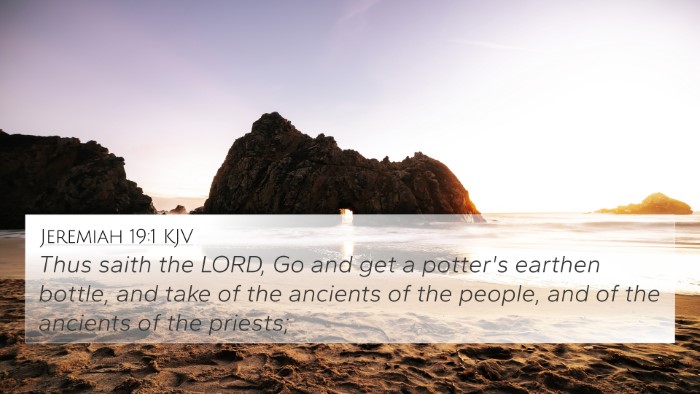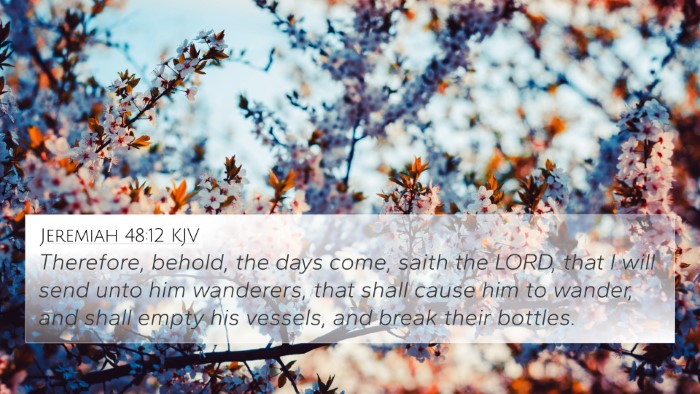Understanding Jeremiah 19:10
Jeremiah 19:10 states: “Then shalt thou break the bottle in the sight of the men that go with thee.”
This verse holds significant meaning within the prophetic message of Jeremiah, emphasizing the destruction that is to come upon Jerusalem and its people due to their unfaithfulness to God.
Commentary Summary
Insights from renowned public domain commentaries such as those by Matthew Henry, Albert Barnes, and Adam Clarke guide our understanding of this verse. In this passage, the breaking of the bottle is symbolic, illustrating the fragility of Israel's situation and the dire consequences of their sins.
Symbolism of the Bottle
According to Matthew Henry, the bottle represents the people of Judah—delicate and breakable, subjected to the impending judgment of God. The act of breaking the bottle signifies the irrevocable decision of the Lord regarding the fate of Jerusalem.
Albert Barnes emphasizes the prophetic nature of Jeremiah's actions, pointing out that the bottle, once shattered, cannot be repaired, symbolizing the total and complete destruction that awaits the city. This visual act serves as a stark warning to the people about their impending doom if they do not repent.
Adam Clarke elaborates on how this dramatic symbolism conveys the message of loss and the end of an era for Jerusalem. Clarke highlights the significance of prophetic actions in that period, where such symbolic gestures captured the attention of the people and communicated God's displeasure.
Cross-References to Jeremiah 19:10
Numerous Bible verses share themes and messages that connect with Jeremiah 19:10. Here are some notable cross-references:
- Isaiah 45:9 - Discussing the consequences of resisting God.
- Ezekiel 24:3 - A similar act of prophecy involving the cooking pot as a representation of judgment.
- Matthew 7:26-27 - Comparing the foolishness of ignoring divine warning to the structure built on sand.
- Luke 20:18 - Specifying the fate of those who fall on the stone, highlighting the inescapable judgment.
- Romans 9:22 - Recognizing God's sovereignty in showing wrath and power.
- 2 Peter 2:6 - Referencing the judgment on cities that did not heed God’s warning.
- Revelation 18:2 - Speaking of the fall of Babylon, correlating with the theme of destruction for disobedience.
- Jeremiah 7:20 - Related to God’s anger burning against the disobedience of His people.
- Jeremiah 16:13 - Prophecy of God scattering them due to their refusal to turn back to Him.
- Zechariah 11:17 - A prophetic reflection of judgment through metaphorical representations.
Thematic Connections
The theme of judgment is prevalent throughout these verses. Jeremiah’s prophecy in 19:10 serves as a microcosm of the wider narrative found in scripture, where disobedience leads to dire consequences. Utilizing a Bible concordance can provide deeper insights into how these verses validate each other and enhance understanding.
Through Bible cross-referencing, it becomes evident how interconnected the scriptures are, with themes of divine justice and the call for repentance resonating through both the Old and New Testaments.
Tools for Bible Cross-Referencing
For those interested in studying Bible verses that relate to each other, it is essential to employ reliable tools such as:
- Bible concordance - A comprehensive guide to finding words and their occurrences.
- Bible cross-reference guide - Helps locate related verses efficiently.
- Cross-reference Bible study - Strategic methods to engage with scripture cross-referencing.
- Bible reference resources - Essential for deeper theological study.
Conclusion
Jeremiah 19:10, with its potent symbolism of the breaking of the bottle, serves as a clarion call for faithfulness to God. The corresponding cross-references elucidate its themes of judgment and divine authority. By utilizing cross-referencing Bible study methods, believers can enrich their understanding of scripture, discovering the profound connections that illuminate God’s word.
